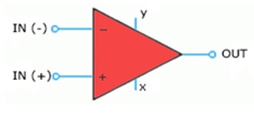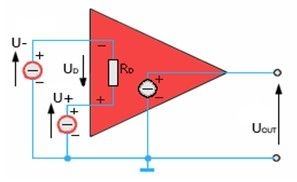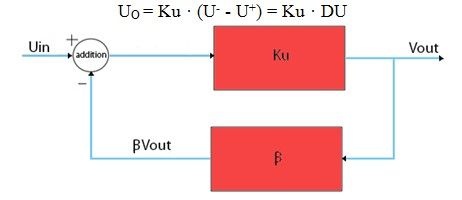Operational amplifier
The operational amplifier – direct current amplifier characterized by very high gain. It is used to amplify the voltage or power, usually operates with an external negative feedback, the characteristics of which determine the function of the entire system. They have a very high input resistance and very low output resistance. The first operational amplifiers were used to perform mathematical operations such as additions, subtractions or integrations, hence the name “operational”.

The input with the “–“signis the inverting input (that shifts phase of the input signal for 180 degrees towards output), and the input with the “+” sign is a non-inverting input. To allow the occurrence of positive and negative voltages on the input as well as the output, it is crucial to power it with positive and negative voltage through “x” and “y” ends.

“U-” signal was applied to the inverting input of the amplifier, and “U+” at the non-inverting input. The signal that occurs between the inputs is a UD difference signal expressed as the difference of U – U + signals. There is also a differential RD input resistance between the inputs of the amplifier. The voltage on UOUT output is comparable to the UD voltage. Ku coefficient is a designation of voltage gain of the open loop amplifier. From the before-mentioned analysis the relationship occurs as follows:

During designing and analysing systems on operational amplifiers, it is assumed that the amplifier is perfect, which means that it has the following characteristics:
Infinitely high gain in open loop (Ku -> ∞)
Infinitely high input impedance
Output impedance is zero
Infinitely wide frequency response
Output voltage equals zero for the same input voltages
Zero input current (current is not drawn from the external circuits)
Infinitely high allowable output current
No interference of their own
Its parameters do not depend on temperature
Operational amplifier – real characteristics:
Open-loop gain coefficient reaches very high but finite values (Ku -> 104-107)
Input impedance is in the range of 104 to 1013
Output impedance of several dozen
Upper frequency limit of several dozens of MHz
There is an input current of low rate of 10-4-10-15 A
They produce self-interference
Parameters of the amplifier are dependent from temperature and they change with time of use of the system
Basic operating systems of operational amplifiers:
Inverting and non-inverting amplifier
Summing and differential amplifier
Integrator
Voltage follower
Current – voltage converter
Phase shifter
The operational amplifier has been applied in a number of systems:
In analogue electronic circuits, where it is responsible for performing mathematical operations,
in logarithmic amplifiers,
in filters,
in some generators,
in linear detectors and peak detectors,
in sampling circuits with memory.
Source: 911electronic.com/operational-amplifier-work-tutorial/



